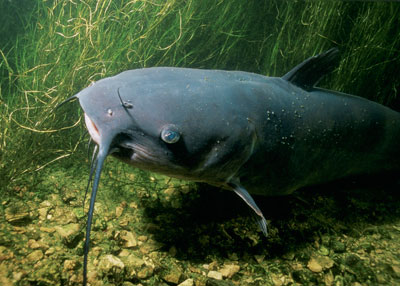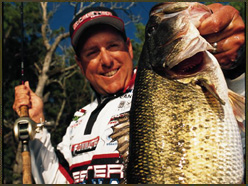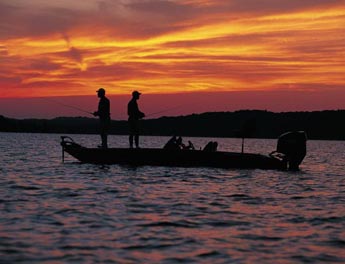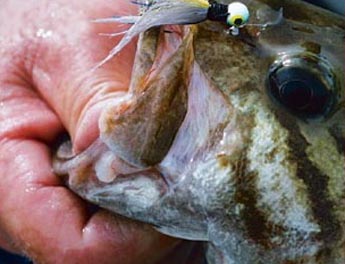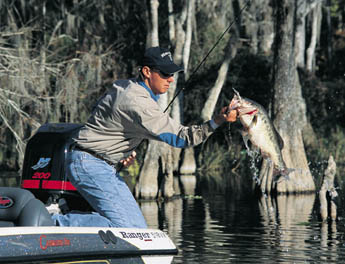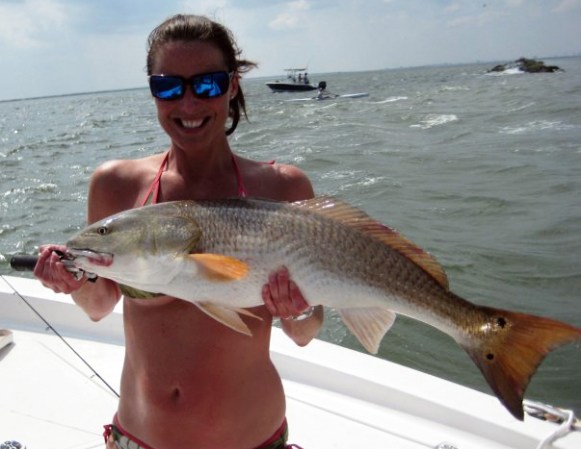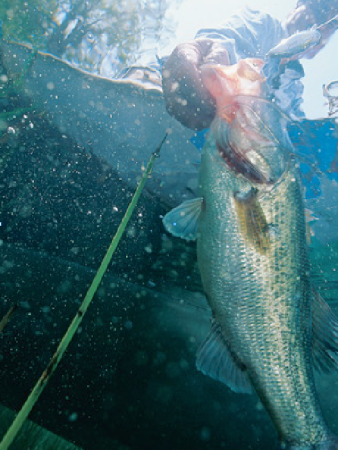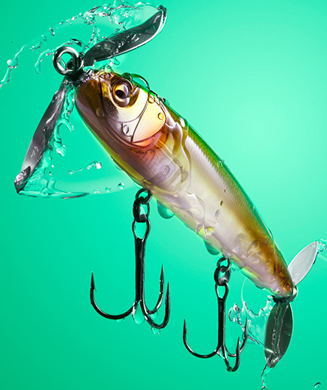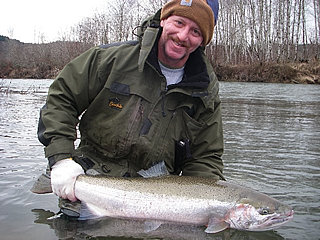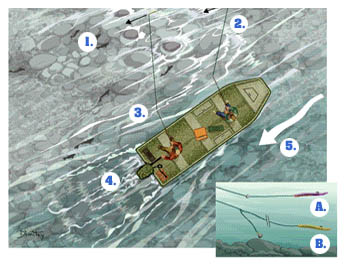The look on the poor lad’s face was a mix of horror and fear: horror at the reality of what he’d just done and fear that–uncle or no uncle–I might toss him overboard. Back on the stern casting deck I heard my son Jon’s soft “uh-oh.” I detected a hint of amusement in it.
Visually, it had been a dramatic faux pas. My young nephew Bobbie had listened well to my directive about getting the big crankbait out there as far as he could. That urging was based on my previous day’s spotty fishing. The fish that had struck–either Goliath-size pickerels or largemouth bass–were holding off the weed line along which I was now slowly moving the boat. Long casts 30 to 40 degrees out from the grass line covered the first depth drop and passed the lure obliquely along the vegetation. Like Barry Bonds going for his 73rd homer, Bobbie had wound up to send the lure into the next county. Great cast: The goose-billed lure sailed out and out. Unfortunately, so did my rod and reel. Flashing in the sun, the rig made one complete turn before it speared the surface and vanished.
Well, I hadn’t given him my best outfit. Besides, there was a backup plan. In retrospect, I realized it was the strategy with which we should have begun. Why burden a beginning angler with physically demanding or fussy techniques under tough conditions when all he wants to do is catch any sort of fish? So we ran up the lake to an underwater ledge off a long point and tossed out little Beetle Spin spinnerbaits, let them sink into a break in the rock and cranked them steadily back. We wore out a school of aggressive rock bass. Bobbie was delighted. We switched to a ledge that transitioned to a weedy flat, then some rock. Gangs of big yellow perch that acted as if they were famished attacked the little spinners. We kept a batch for one of Aunt Judy’s stellar fish fries (yellow perch from cool water being one of the world’s finest eating fish).
CATCH FISH, HAVE FUN
Backup fish, backup tactics. Unless you’re glued by dint of some event or mental fix to fish for a target species, why not lighten up and have some fun? Sure, staying with the fish for which you came and hammering away using different techniques in varied locations is likely to improve your skill. But if you’re out there to relax, and especially if you’re fishing with youngsters or newcomers to fishing, those other fish in the lake can be heroes.
I keep several light spinning and bait-casting outfits stored in my boat, plus lures and terminal tackle that often are simply scaled-down versions of larger gamefish rigs. My usual targets are whatever panfish are in the lake or river. I might start with, say, crappies or white bass for a feed, then switch to largemouths. Or I might troll for walleyes for a while and then go after smallmouths. If your lake has them, throw northern pike or muskies into the mix, especially this time of year.
My backup selection of lures and terminal rigs includes small spinnerbaits and feathered spinner-jigs (such as a marabou-dressed Road Runner); in-line spinners (Mepps, Rooster Tail, Panther Martin, etc.); plastic grub-bodied, marabou-tailed jigs (Lindy Fuzz-E-Grub); generic all-marabou jigs; weedless jigs (Lindy No-Snagg Veg-E-Jig), small soft twitchbaits (Slug-Go, Fin-S-Fish) and downsized floating minnow lures (Original Rapala, Rebel). My mainstay jigs are 1/8 and 1/4 ounces, but I also have 1/16- and 1/32-ounce models.
Terminal tackle includes barrel swivels and weights (cone-shaped for weeds, walking-type sinkers for rock, Lindy Rattlin’ No-Snagg sinkers for varied bottoms). These items (along with extra mono for leaders) are used to build slip-sinker rigs. I might work floating minnow lures and small plastic twitchbaits on the slip-sinker rigs. I use live bait on them, too; you’ll need some small short-shank or circle hooks to do that.
I also keep quick-change Bakudan weights (from Lunker City) for drop-shot rigs. As is the case with the slip-sinker rigs, my drop-shot setups might be used to present small twitchbaits, floating minnowbaits, tiny marabou-tailed jigs or natural bait. I also carry some slip floats with bobber stops small enough to be cranked onto a reel. The slip floats are used to suspend natural baits, jigs or both together. Depending on season and location, live bait can be small worms (or crawlers), minnows, leeches or maggots. When you’re packing this tackle selection, it’s hard to go home skunked.
NO SPECIES OFF-LIMITS
Many times while hopping a minnow bait or sweetened jig on a drop-shot rig, I’ve had walleyes or big pike grab on; I’ve managed to boat some of the latter despite the lack of wire leader. I often nab big largemouths while fishing a slip-sinker rig with small live minnows for crappies, or jiggling a bit of a crawler on a drop-shot rig for big bluegills in weed cover. Smallmouths are so likely to chomp a perch rig–a worm-sweetened jig suspended below a slip float–that I use that rig prospecting for bronzebacks when they’re refusing other presentations. Backup fishing can be full of surprises.
There’s another twist if you want to put more fun in multi-species sport fishing. In my game, you agree beforehand to the day’s allowable species where you’re going to fish. Whoever catches the most species, or whoever catches the heaviest fish in the most categories, wins. On a lake where I used to live, we began playing this game targeting yellow perch, rock bass and chain pickerel; in spring we included bullheads. Later in the season we added largemouth and smallmouth bass and removed bullheads again. The exercise made us more studious of changing weather and water conditions as they affected fishing.
If you want a way to improve your skills as a multi-species angler, give that sort of tournament a try.
Long-Range Float
Getting good cast distance with small lures or natural live baits is a job for weighted floats. Elongated aerodynamic designs cast far better than round bobbers. However, once you weight the line to keep bait down, such sensitive floats might ride on the water with just the slender tip visible. Unless the light’s just right, it’s sometimes difficult to see the floats at a distance, which defeats one of their purposes.
Enter Gary Carmichael’s Aquadart float, which is cigar-shaped and weighted at one end. The float sports a dartlike shaft and flight “feathers” that allow it to be cast like a bullet. The Aquadart enters the water with little commotion and is easy to spot. Wind can move the exposed float in the water when it catches the upright dart flights, but overall these rigs answer a need for shorebound fishermen and even boat anglers attempting to work schooling fish without putting them down by approaching too close. The Aquadart can be rigged so that it stays fixed or is allowed to slip up the line for deep-water applications. (About $5 each, plus shipping and handling, Old Lake Products, P.O. Box 1358, Jamestown, NC 27282, 336-885-7818; www.oldlakeproducts.com)
JERRY SAYS…
BOUNCE THE BOTTOM FOR PANFISH: Those wire wishbone bottom-bouncers aren’t just for walleyes. Troll them with a small floating minnow lure or small snelled spinner/worm rig to locate panfish schools. Use the lightest-weight bouncer you can get away with while still maintaining bottom contact.
For more fishing information, go to www.outdoorlife.com/fishing

